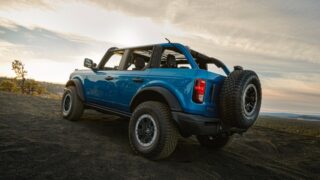|
The Revolution Under The Hood At Ford: Better Performance & Fuel Economy, Reduced Emissions
- Unprecedented number of new powertrains help improve fuel economy and reduce emissions
- Variety of new engines: All-new global I-4 and new 3.5-liter V-6, new 3-valve V-8 engines
- 70 percent of Ford’s automatic transmissions to be new by 2008
- New hybrid-powertrains powering Ford Escape and Ford Futura
- New diesel-powered vehicles in Europe; studying diesel further in North America
- All dual-overhead-cam gasoline engines in North America to be named Duratec
DEARBORN, Mich., July 15, 2003 – Today’s announcement of an all-new 3.5-liter V-6 engine is just the latest in an unprecedented line of new powertrains being introduced between this year and the end of the decade by Ford Motor Company.
Ford is introducing new, more efficient and cleaner yet at the same time more powerful engines from small to large such as an all-new global I-4 engine and an all-new 6.0-liter Power Stroke® Diesel. In between are Ford’s all-new dual-overhead-cam Duratec 35 V-6 and 3-valve per cylinder V-8 engines with variable-cam timing such as the new 5.4-liter Triton? V-8, which powers the all-new 2004 Ford F-150.
“There’s a revolution going on under the hood at Ford,” said Dave Szczupak, vice president, Powertrain Operations, Ford Motor Company. “There is a true belief here at the Ford Motor Company that the powertrain is the heart of every car. We are introducing an unprecedented number of new powertrains between now and the end of the decade. The things we are doing today will assure that we continue to deliver great powertrains and great vehicles to our customers well into the future.” In addition to new engines, 70 percent of Ford’s automatic transmissions in North America will be new by 2008 – from continuously variable transmissions (CVTs) being introduced on the Ford Freestyle, Ford Five Hundred and Mercury Montego to the new TorqShift? 5-speed on F-Series Super Duty to 6-speeds being introduced mid-to-late decade.
The quality of Ford’s current transmissions also is the highest it has ever been due to the implementation of various quality initiatives such as Consumer Driven 6-Sigma, a data-driven approach to finding engineering solutions.
Summary of What’s New:
- Partial-zero emissions (PZEV) Ford Focus in California, New York, Massachusetts and Vermont beginning in early 2003, made possible by an all-new global I-4 engine. The new 2.3-liter engine is available in Focus nationally this fall. An all-new 2.0-liter engine, based on same engine architecture, will be available in the spring of 2004.
- All-new 3.5-liter V-6 family of engines to power Ford, Lincoln and Mercury vehicles beginning in early 2006. Production begins by end of 2005.
- New 4.6-liter, 3-valve V-8 engine in development, to power variety of future Ford, Lincoln and Mercury vehicles, including sport-utility vehicles (SUVs) and passenger cars.
- New 300-horsepower 5.4-liter, 3-valve Triton™ V-8, introduced on the 2004 Ford F-150.
- 500-horsepower Ford GT supercar, to be introduced next year in limited volumes.
- All-new 6.0-liter Power Stroke Diesel and TorqShift® 5-speed automatic, powering Ford’s F-Series Super Duty and E-Series models.
- Hybrid-electric power will appear in high-volume, mainstream Ford Motor Company products such as the Ford Escape and Ford Futura where they can make the most impact on fuel economy and emissions.
- Ford also is introducing a new lineup of innovative transmissions during this decade, such as the new TorqShift® 5-speed automatic. By 2008, 70 percent of Ford’s automatic transmissions in North America will be new (based on volume).
- Electronic throttle control, a feature that is a direct descendant of technology first used in fighter jets and helps to improve powertrain response and efficiency, was introduced on the new 2004 F-150 and in recent years the Ford Thunderbird and Lincoln LS.
Ford’s Duratec Engine Families
As a part of Ford’s powertrain strategy, all dual-overhead-cam (DOHC) four-cylinder and six-cylinder gasoline engines in North America will be identified as Duratec (which stands for “Durable Technology), taking the name of Ford’s popular line of 3.0-liter V-6 engines.
Ford’s Duratec line of engines will now consist of engines based upon Ford’s all-new global I-4 engine, the current Duratec 3.0-liter V-6 and Ford’s new 3.5-liter V-6. The naming of the engines will be based upon the displacement of the engine with special engines like the PZEV Focus engine denoted by a letter (in this case E, standing for environment, efficiency or ecological).
Following is a summary of Ford’s Duratec line of engines (Duratec 20 and Duratec 23 will power the Ford Focus):
- Duratec 20 (all-new 2.0-liter I-4)
- Duratec 23 (all-new 2.3-liter I-4)
- Duratec E (all-new PZEV variant)
- Duratec 30 (current 3.0-liter V-6 engine architecture)
- Duratec 35 (all-new 3.5-liter V-6)
Technology leads the way
Ford Motor Company’s approach to powertrain development assures that as ever cleaner and more fuel-efficient engines go into the products of today and tomorrow, customers don’t have to pay a price in reduced performance.
In fact, thanks to modern engine design and sophisticated electronic controls, the opposite is true – Ford’s newest engines, such as the 5.4-liter, 3-valve Triton V-8 and the Power Stroke, offer more power and performance, and are quieter and more durable than ever before, all while producing fewer emissions and offering improved efficiency.
Ford’s investment in technology has paid off in both products and processes. For example, the modular V-8 engine family that began life in the early 1990s as the 4.6-liter, single-overhead-cam (SOHC) engine on the Lincoln Town Car has since given birth to a host of variations, including high-performance four-valve engines displacing 4.6 and 5.4 liters; the 4.6-liter and 5.4-liter Triton V-8 truck engines; 6.8-liter Triton V-10; as well as the supercharged SVT F-150 Lightning and SVT Mustang Cobra engines.
Ford’s “MOD” V-8/V-10 engine family has proven to be adaptable to the latest engine control technologies – including many that weren’t even on the drawing boards when the original modular engines debuted.
Sophisticated computer-aided engineering tools have enabled engineers to tune out unwanted sound and vibration in the engine block, while computer-aided manufacturing tools allow them to pre-run assembly lines, to ensure the most efficient manufacturing processes. At Ford’s Livonia, Mich., transmission facilities – the worldwide “center of excellence” for Ford Motor Company automatic transmission development and testing – engineers use one of the world’s most powerful X-ray machines to examine engines and transmissions to ensure quality.
This seamless integration of technology into daily work processes is reflected in the extensive use of electronic controls in Ford Motor Company’s new engines and transmissions. These systems continuously monitor and analyze total vehicle performance and driver inputs, and adjust the engine and transmission to deliver the desired response.
New 4.6-liter and 5.4-liter, 3-Valve V-8 Engines
Ford Motor Company’s newest innovation is the 5.4-liter Triton V-8 engine, which uses three valves per cylinder – two intake and one exhaust – along with variable-cam timing and other technologies to deliver a new level of performance and refinement. This engine, combined with fuel-saving futures like electronic throttle control, debuts in the all-new 2004 Ford F-150.
“The new 5.4-liter Triton V-8 will be the newest member of our ‘300 Club,’ with more than 300 horsepower and class-leading torque across the entire rev range,” said Pete Dowding, manager of Ford’s modular engine programs. “We were the first to introduce sophisticated overhead-cam engines in pickup trucks. Now we are launching second-generation technologies for improved performance, efficiency, emissions and quiet, smooth operation.”
A 4.6-liter version of Ford’s new 3-valve per cylinder engine will debut in late 2004 and will power a variety of future Ford, Lincoln and Mercury vehicles, including sport-utility vehicles (SUVs) and passenger cars. Production will begin at Ford’s Essex Engine Plant in late 2004 and at Ford’s Romeo Engine Plant by the end of 2005.
At the end of April, Ford built its 100-millionth V-8 engine – a 5.4-liter, 3-valve Triton V-8 for the 2004 F-150. Henry Ford introduced the first mass-produced V-8 engine in 1932.
New 6.0-liter Power Stroke Diesel
Ford’s new 6.0-liter Power Stroke Diesel engine was introduced earlier this year on the popular F-Series Super Duty line of trucks and will replace the well-regarded 7.3-liter Power Stroke in the E-Series Super Duty lineup in the 2004 model year, offering even more power with better response and quieter operation.
This engine is matched to the new TorqShift 5-speed automatic transmission. This combination, designed by engine and transmission engineers working as a team, will deliver exceptional durability and towing performance and improved fuel economy.
One of the benefits of this holistic approach to powertrain design is a driver-activated “tow-haul” mode, in which the electronic powertrain controller is able to sense when engine braking is needed in a steep descent, and automatically downshift the transmission once or twice, depending on circumstances, to help the driver maintain a comfortable feeling of control.
New Global I-4 Engine
At the opposite end of the size spectrum from the Power Stroke Diesel is Ford’s new I-4 engine family (Duratec 23), which powers the new partial-zero emissions (PZEV) Ford Focus, introduced in the spring of 2003.
This modern four-cylinder engine family has the potential for more than 100 variations in a wide range of vehicles around the world, whether optimized for fuel economy, sport performance or torque, as in the Ford Focus. Ford eventually expects to build more than 1.5 million I-4 engines annually, which would account for 20 percent of Ford’s total annual engine production of 7 million engines.
The new global I-4 also is leading the way in modern and cost-efficient manufacturing, under Ford’s global manufacturing strategy. This engine, to be built in four engine plants on three continents, will benefit from the efficiencies and quality improvements offered by flexible manufacturing techniques.
Common-rail diesels
In Europe, Ford has partnered with PSA Peugeot Citroën to develop a line of industry-leading, common-rail diesel engines, which offer dramatic fuel-economy benefits, without any of the negatives often associated with diesel engines. Common-rail technology uses electronic control of the diesel engine’s fuel injection system to eliminate harshness, noise and excessive exhaust smoke and odor.
Ford Motor Company believes that North American consumers will embrace this promising technology, with infrastructure improvements and availability of low-sulfur diesel fuel starting in late 2006. Ford leads the way in small-diesel technology in the European market and is studying diesel options in North America, such as offering a diesel-powered Ford Focus within the next five years.
Powertrain innovations continue
In 2004, Ford will begin building a new version of its Duratec V-6 engine for the new Ford Freestyle, Ford Five Hundred and Mercury Montego. Each vehicle will feature continuously variable transmissions (CVTs), for smooth, step-free operation and improved fuel economy.
For 2003, the new Lincoln LS received updates that make its dual-overhead-cam (DOHC) 3.0-liter V-6 engine among the most powerful naturally aspirated engines of its size on the market. Continuously variable intake valve timing allows engineers to optimize performance, making it one of the top 3.0-liter V-6 engines in the world in both torque and horsepower. The electronic engine controller automatically chooses from four possible intake manifold configurations, for best performance. Electronic throttle control provides a host of benefits, including improved responsiveness.
By the end of 2005, Ford will introduce a new DOHC 3.5-liter V-6 engine, which will power a variety of Ford, Lincoln and Mercury products.
New transmissions coming
Seventy percent of Ford Motor Company’s transmission lineup will be all new by 2008, due to new 6-speed front-wheel drive and rear-wheel drive transmissions and the new CVT, in addition to the new 5-speed TorqShift transmission introduced in the 2003 F-Series Super Duty.
These new 6-speeds will use a compact, lightweight architecture, and will feature wider ratio spans than the transmissions they replace. This offers both better launch performance in lower gears and better fuel economy at highway speeds.
“Typical automatic transmissions offer a relatively low ratio span – in the range of 3.5 to 4.0,” said Phil Yuhasz, chief engineer, Automatic Transmission Operations. “Our new 6-speed transmissions and our new continuously variable transmissions will both offer a ratio span of 6.0. We expect our new Ecotronic CVT to offer fuel economy improvements of up to 8 percent.”
All of Ford’s carryover transmissions also will be heavily revised – a process that is already paying dividends. Customer satisfaction and the quality of Ford’s automatic transmissions are at their highest levels in years.
In addition, Ford Motor Company and General Motors Corp. recently announced a memorandum of understanding, in which they will work together to develop a new front-wheel drive 6-speed automatic transmission that will offer fuel economy improvements over current front-wheel drive products.
Ford also is partnering with transmission specialists ZF on CVT design and production. The new Ford Ecotronic family of second-generation CVTs will be built at ZF Industries Batavia (Ohio) Transmission Plant near Cincinnati. Production is to start by the end of this year at the Batavia plant for European vehicles and in 2004 for North American products.
Advanced Propulsion
Ford Motor Company was the first manufacturer to announce a hybrid-electric sport utility, the Ford Escape Hybrid, which will debut in 2004. Ford also is applying hybrid technology to fuel cell vehicles, with its new Focus Fuel Cell Vehicle. The Focus FCV is expected to achieve a 160-200 mile (250-320 kms) operating range – a significant improvement on previous fuel cell vehicles with no sacrifices in performance.
Ford remains the leader in the alternative fuel vehicle (AFV) market, producing more AFVs than all other manufacturers combined. Ford offers products that operate on natural gas, propane, ethanol or combinations of alternative fuels and gasoline.
Flexible manufacturing
Flexible manufacturing offers multiple benefits to a carmaker – dramatically lower production costs and greater ability to respond to changing marketplace needs and consumer tastes.
Ford Motor Company has already begun introducing flexible manufacturing techniques at its engine plants worldwide. The cylinder-head line at Windsor (Ontario) Engine Plant, which will produce the 5.4-liter, 3-valve Triton V-8, features all-new fully flexible manufacturing. After a $350-million overhaul, the Cleveland Engine Plant No. 1 will use flexible manufacturing to the 3.0-liter Duratec V-6. Romeo and Lima both will install flexible manufacturing systems in 2005.
“Our standardized global manufacturing strategy allows us to quickly adopt best practices from around the world,” said Kevin Bennett, director of Powertrain Manufacturing Engineering for Ford. “We’re able to get a plant up and running more quickly and at less cost than ever before. And we’re able to deliver better quality products to our customers.”
Heart of the vehicle
Ford Motor Company’s powertrain development and manufacturing involve hard work and innovative thinking by thousands of professionals, from the computer workstations to the assembly line. Because this activity takes place behind the scenes, it is easily overlooked.
That is, until the moment you step on the accelerator. Then there’s no hiding, and no excuses.
From small vehicles like the Ford Focus and Escape Hybrid to supercars like the Aston Martin Vanquish with its 460-horsepower V-12 engine and the new 500-horsepower Ford GT, Ford Motor Company’s mission is to deliver great powertrains.
“For more than 100 years the internal-combustion engine has not really had a true competitor,” said Szczupak. “It has been the chosen method of powering vehicles.
“Now with hybrids, internal-combustion engines fueled with hydrogen and fuel-cell vehicles on their way, traditional powertrains are being pushed now more than ever before to be near zero in emissions and to maximize fuel economy,” he added. “At the same time the customer expects no compromises with performance. Through our work here at the Ford Motor Company, we feel the internal-combustion engine is up to the challenge, and the best is yet to come.
“It’s fitting that as we mark 100 years as an automotive company, we continue to build on the powertrain leadership that Henry Ford established,” Szczupak concludes. “From that first removable cylinder head in 1908 on the Model T to the famous 1932 V-8 to the all-new 3-valve cylinder head on the 5.4-liter Triton V-8, Ford has continued to write the history of performance.”
|




